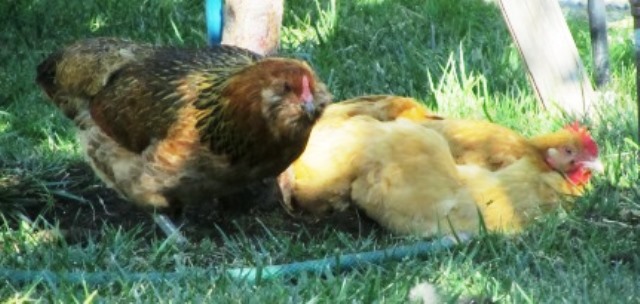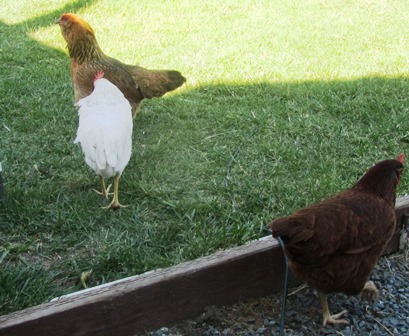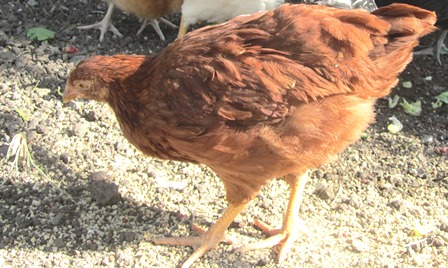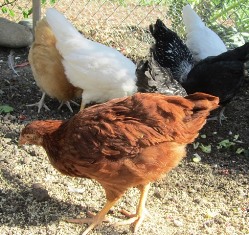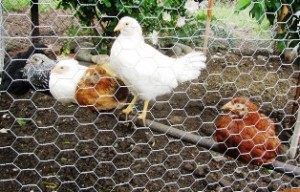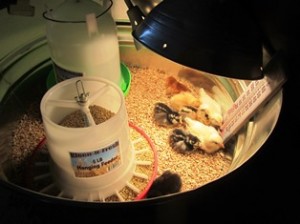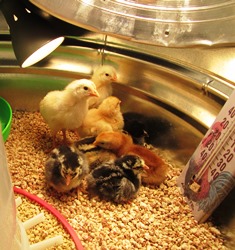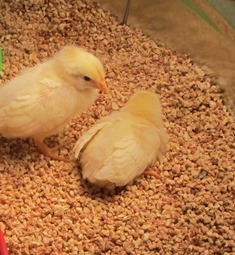Buffo’s Gone Broody
My Buff Orpington hen won’t leave the nest. I’ve taken to putting out a bowl of crumbles and a canister of water so she’ll have nourishment while she sits on a a pile of eggs.
I’m beginning to think that with her this broody period is going to happen about every six months–at least that’s been the case so far.
Ruby the Rhode Island Red, the Wyandotte sisters, the Black Sex Link, and my two white leghorns are being de-laned into the two other boxes. And I have to practically crawl into the chicken house to reach the last nest box to retrieve their eggs.
Our town doesn’t permit us to keep roosters. Ergo, those eggs that Buffo is trying to hatch will have to be tossed at the end of her broody period. They’re not fertile and will never hatch. But I haven’t the heart to tell her.
* * *
If you enjoy reading about farmette life, check out my cozy mystery novel series from Kensington Publishing, New York. The books feature a farmette milieu, farm sayings, tips, and facts as well as delicious recipes to try. The books are available from online sources such as Amazon, Barnes & Noble, Walmart and others as well as traditional bookstores everywhere.
The Prolapsed Vent Issue
It happened to one of my chickens a few years ago; now, it’s happened again.
My one-year-old Ameraucana hen–a blue-egg layer–developed a prolapsed vent from trying to lay a too-large egg. The first time it happened, I did all the things I’ve learned to do: separate her from the flock, reduce light, nutrition, and water (to stop her from trying to lay more eggs).
I used a lukewarm towel to clean her. Latex gloves and vaseline to try to push the vent/cloaca back in. And it worked for a while. It took her a couple of weeks to recover. Elated, I thought she would be fine. Not so.
By the time I realized it had occurred again, the other chickens had been pecking her–drawing blood–and she seemed weak, wobbly, and near death. I repeated the previous steps, thinking she’d pull out of it, but by morning she was gone.
Disheartened, I began to search chicken forums on the Internet to find out which breeds are susceptible to this issue. I learned the Cornish game hens and chickens that are bred for meaty bodies are more likely to have the vent prolapse, but I haven’t yet learned whether or not the Ameraucanas are equally susceptible. If anyone knows, drop me a line. Thanks.
Help–There’s a Chicken on My Back
Collecting eggs, I bent over into the chicken house. Suddenly, a large chicken land on my back and start talking to me in her chicken language. I immediately knew it was my Rhode Island Red. She follows me everywhere.
It would have made a cute picture, but here’s the thing: you don’t want chickens tarrying too long in one place because they are famous for frequent and abundant droppings.
The Rhody is the most personable chicken in my flock and the one I handled the least when I cared for the flock of baby chicks in a tub in my kitchen. However, the chicken I handled the most from my tub of baby chicks was the yellow Buff Orpington, and today she’s difficult with the other hens and its also the first to have gone broody.
As I do chores around the farmette, the Rhody keeps me company. When I go inside to work in my office on my writing projects, she often hangs out under my office window, clucking or making an number of various chicken sounds. She also responds to my voice when I call out her. If I had it to do over again, I’d have a whole flock of Rhode Island Reds, just for the personality.
Big, Blonde Buff-O Goes on the Attack
The yellow-colored Buff Orpington hen seemed so cute when she was all down and a day old.
But six months have passed, the Buff-O has feathered out and gone broody. Today, she showed me a nasty-tempered, cranky hen, with ruffled feathers who will stop at nothing to hatch the clutch of eggs she’s sitting on.
The problem is that some of those eggs in the nesting box aren’t hers, and they’re all unfertilized since we have no rooster.
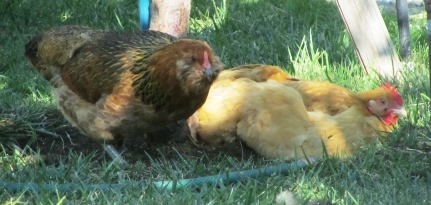
From left to right: Furry Face, the Ameracuana, and Buff-O, the Buff Orpington, when they used to sun themselves together
Buff-O has been sitting on the clutch of eggs for almost three weeks now, barely leaving to eat or drink. But today, she exited the hen house to take dirt bath–that’s how chickens clean themselves. Toss on the dirt, roll in it, then get up and shake like a dog, flinging the dirt in all directions as far as possible.
Before the fight started, all nine of my hens were foraging on our property, except for Buff-O and the shy Ameracauna with the furry face. The latter was in the chicken run, scratching the dirt, minding her own business.
I saw Buff-O walk over and lunge at Furry Face in attack mode. She used her beak to viciously peck Furry Face’s neck and her clawed toes to tear at the poor shy chicken’s back. She seemed more rooster than hen.
I ran for the hose and separated the two with a spray of water. Then, with both out of chicken run and into the yard, I gathered up all those unfertile, soon-to-be-rotten eggs that Buff-O has been trying in vain to hatch, and headed toward the garbage can.
But apparently, tossing those eggs changed nothing. Buff-O is back in the hen house on the nest–albeit, a different nesting box than before. But the straw in the original nesting box is still warm. It’s being occupied by Furry Face. Go figure!
You Can’t Hurry a Chicken into Laying an Egg
I brought home my little flock of baby chicks on March 7. Yesterday marked 16 weeks or four months. That’s important because that’s when the feed store told me I could start expecting eggs from my White Leghorns. Not with mine. They are taking their own sweet time.
The Rhode Island Red can take between 20 and 26 weeks–or so I’ve been told–to start laying. Mine just wants to forage in the yard, follow me around, get in my face, and eat any extra blueberries that I didn’t consume with my morning yogurt and honey. I had a talk with her yesterday about how I’m expecting some eggs in return for all those blueberries.
My flock also includes a Buff Orpington, a Black Sex Link, an Ameraucana, and two Silver Laced Wyandottes, the latter is an old heritage breed can take up to 32 weeks to begin laying. So maybe around Halloween, I’ll find their first offerings.
In anticipation of the big egg-laying event, I’ve switched the chicken food to a crumble for laying hens. Tomorrow I will buy some oyster shell calcium for strong egg shells. I’ve also tucked smooth, wooden eggs into their nesting boxes with some soft straw, hoping to encourage the girls to get with it.
Their voices have now changed from the peep, peep, to cluck, cluck. But I’ve yet to hear that loud cackle that tells me an egg has been laid. Sometimes I’ll see one of some serious squatting and get excited. Okay, this is it. But so far, it isn’t.
So the watch goes on. You can’t hurry a chicken who isn’t ready to produce eggs. So in the meantime, I’ll be eating a lot more yogurt and berries for breakfast.
Dealing with a Flock of Stressed-Out, Feathered-Out Chicks
Now that the weather has turned warm here in Northern California, I have moved my baby chicks from the huge box in my kitchen to our newly constructed chicken house. I don’t know for certain, but I think they were feeling stressed out in the box and I was stressed from the noise and their behaviors of pecking each other and trying to fly out of the box.
The hen house has two windows that open and close for ventilation, nesting boxes, a front door for my access, a back exit door with stairs for the chickens to enter and leave, and a couple of perches inside and out. We wired a poultry screen over the top of the chicken run because of the predatory habits of local hawks.
Our chicks range in age from eight and ten weeks and are all feathered out. I feed them medicated crumble and provide fresh water daily. To ensure strong legs, I cover the chicken house floor with a bed of dried, crushed corn cob. I also have stuffed straw into the three nesting boxes so that when the chickens are ready to begin laying, they’ll have a bed ready.
The chicks are growing so fast, their girth and height seems to double every week. The bulk of their diet is crumble, but with an occasional treat such as shredded fresh lettuce and spinach leaves. Their activities and often-flighty behaviors are notable for chickens. They take dust baths, scratch the earth for grubs and worms, run at each other while seemingly intent on crashing only to avert at the last minute, perch together to roost, and peck their housemates. Oh, the pecking!
Guess which chicken is the most aggressive pecker from my flock that includes White Leghorn, Silver-Laced Wyandotte, Buff Orpington, Rhode Island Red, Black Sex Link, and an Ameraucana. Turns out,in my flock, the most aggression is shown by the Buff Orpington.
From day one, “Buffy” has pecked the quiet Ameraucana. Before the Ameraucana had feathered out, blood would flow from her back from Buffy’s senseless pecking. I tried to separate them, giving Buffy time outs and hoping to stop her behavior. It seemed to work . . . or, maybe I was just imagining it was.
I placed a dab of antibiotic cream on the back of the Ameraucana and within days, her pecking wound healed and now she’s feathered again over the wound. The move to the chicken house reduced the stress of living out of a box in the kitchen. Now the chickens seem to get along fine, even enjoying their life in the hen house.
Last night, Buff huddled up next to the Ameraucana on the roost and this morning I saw the two of them taking a dust bath together. Chicken stress relief. My stress relief. It’s a beautiful thing!
Chicklet Therapy: Raising Baby Chicks
I’m raising a flock of baby chicks in a tub in my kitchen. Watching them is nothing short of a stress-busting exercise. Not only do they provide endless entertainment, but they already show individual temperaments and personality traits that can’t help but make you smile.
Some people raise backyard chickens for both meat and eggs. Others want only eggs (I’m in that group). And there are those who love keeping the more exotic breeds–imagine feathered legs and toes, cheek muffs, beards, and strange-looking combs.
There are so many breeds, it’s hard to keep track of them all. For example, there are the standards like the White Leghorns and Rhode Island Reds; the exotics like the Faverolles (with their five toes, feathered feet, and fluffy beards and muffs), and heritage chickens.
Traditional breeds or “heritage” chickens aren’t as popular as they once were, so their numbers are declining. Some are even considered Of the heritage chickens whose numbers are declining so rapidly that they are considered globally endangered. They include Campines, Andalusians, Buttercups, Catalanas, Sumatras, and other breeds.
My baby chick choices include a Rhode Island Red, a Buff Orpington, two Silver-Laced Wyandottes, two White Leghorns, a Black Sex Link, and an Ameraucana (who lays blue-green eggs). All are known to be good layers, although some are more productive than others.
Egg production can go down during periods of molting (losing their feathers) or broodiness (sitting on the eggs as though they will hatch, which they won’t because without a rooster, the eggs are not fertile). Also, egg production can decline during winter when the daylight hours are shorter.
The following guidance comes from my local feed and pet supply store, Concord Feed, Pet, and Livestock Supply. See, http://www.concordfeed.com. The store’s capable staff are all extremely knowledgeable about chicks. Here are the guidelines.
1. The environment must be clean, warm, and dry (no drafts). Consider a brooder’s box or large galvanized tub filled with dry and mold-free bedding such as corn cob shavings (Bed-O-Cobb is a good one). Avoid smooth, slick surfaces that can cause leg damage.
2. They must have room to roam. The rule of thumb is 1 square foot per chick; when they are six weeks and older, given them 2 square feet per bird.
3. Day-old chicks need 90 to 95 degrees Fahrenheit. To achieve this, attach a heat lamp or light bulb about 20 inches above the chicks. When cold, the baby chicks tend to huddle together under the lamp for warmth; when hot, the chicks move to the corners. You will want to reduce the temperature created by the heat lamp by five degrees each week until you reach the ideal temperature of 65 degrees Fahrenheit. Simply move the lamp further away from the chicks.
4. Hydrate the chicks with a one-quart of fresh, cool water in a dispenser that is changed daily (or more often if they scratch bedding or food into it). A quart container will provide enough water for 25 chicks.
5. Feed the babies with a chick starter until they are 16 to 20 weeks old. By that age, they should be feathered completely. Then begin giving the hens a laying feed to help them produce strong-shelled eggs and provide them with the nutrients they require.
By following these guidelines, I think I’ll be able to have eggs from my little hens by August or September this year, barring any of them turning out to be roosters. In case I must give him up (some cities don’t allow roosters), which I wouldn’t want to do, I’ve already talked to the feed store about rooster rescue organization. For helpful information about keeping chickens, see http://www.backyardchickens.com/
 Facebook
Facebook Goodreads
Goodreads LinkedIn
LinkedIn Meera Lester
Meera Lester Twitter
Twitter







